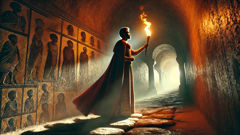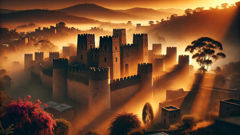Introduction
Beneath the endless sky of Ethiopia’s northern highlands, surrounded by rolling hills and ancient eucalyptus groves, rises the haunting silhouette of Fasil Ghebbi. For centuries, this fortress-city has loomed over Gondar, its thick basalt walls encasing a labyrinth of palaces, churches, and secret passageways. The air itself seems to carry whispers of old—tales of mighty emperors, daring battles, and enigmatic magicians whose legacies are woven into the stones. Here, history and legend blend seamlessly, each brick echoing the ambitions and dreams of those who shaped Ethiopia’s destiny. Travelers arriving at the gates of Fasil Ghebbi, whether in the cool blue dawn or under a burning midday sun, have always sensed something extraordinary. The sharp lines of the fortress cut against the landscape, but within, arches soften the light, courtyards bloom with red bougainvillea, and pools reflect the sky. There’s a feeling that the past never truly left; that the footsteps of emperors like Fasilides, Iyasu, and Bakaffa can still be heard along the worn flagstones. Locals share stories of hidden treasures and tunnels winding deep beneath the city, secret meetings held by moonlight, and a lion’s roar that once signaled both danger and hope. To understand Fasil Ghebbi is to understand the heart of Ethiopia—its resilience, wisdom, and the magic that still lingers in the wind. This is a place where the boundaries of history are blurred, where every legend holds a grain of truth, and where the spirit of Gondar’s golden age waits to be discovered anew.
The Vision of Fasilides: Foundations in Stone and Spirit
The story of Fasil Ghebbi begins with Emperor Fasilides, a ruler whose vision and resolve forever transformed Ethiopia’s heartland. In the early 17th century, as whispers of foreign threats and internal strife grew louder, Fasilides sought to create not just a seat of power but a living symbol of unity and strength. He scoured the highlands for a place both defensible and inspiring, finally choosing a plateau north of Lake Tana—a spot where the morning mists seemed to promise protection and secrecy. Legend holds that Fasilides was guided by a prophetic dream. One moonless night, the emperor saw himself walking beside a lion through thick fog. As they neared a hillock, the lion roared, and the mist parted to reveal a city of stone rising from the earth, shimmering with promise. When Fasilides awoke, he declared that Gondar would be built on that very ground. The site chosen was more than just a strategic perch; it was a crossroads of ancient trade routes, a meeting place for cultures, merchants, and faiths. With determination, Fasilides summoned the kingdom’s finest architects, masons, and craftsmen—many said to be descended from the builders of Lalibela’s rock-hewn churches. Some even whispered that mystical artisans from far-off lands joined them, sharing secret techniques for laying stones that would withstand the centuries.

The construction of Fasil Ghebbi was an epic feat, blending Ethiopian, Portuguese, and Indian influences. Each archway, dome, and crenellated wall was laid with intention. Fasilides personally oversaw the placement of the fortress’s great gate, insisting it face the rising sun—a daily reminder that every ruler’s authority sprang from light and wisdom. As the walls rose, tales spread among the workers. Some claimed to have seen a lion pacing along the ramparts at night, its eyes glowing like embers. Others heard the strains of music and chanting drifting from empty courtyards, as if the spirits of future generations were already celebrating their home. To the people of Gondar, these omens meant the city would be blessed.
Once completed, Fasil Ghebbi became more than a fortress. It was a living city—buzzing with scribes, scholars, priests, and traders. The emperor’s court shimmered with silk and gold, and at dusk, lanterns lit the walkways. Within these walls, justice was dispensed under the shade of sycamore trees, and treaties were signed that would shape the fate of the Ethiopian Highlands for centuries to come. Yet, the greatest legacy of Fasilides was not merely in stone, but in the spirit of unity he inspired. The fortress stood as a beacon, drawing people from all corners of Ethiopia and beyond—each bringing stories and traditions that found new life within its embrace.
Iyasu the Great: The Sage, the Sorcerer, and the Lion’s Secret
Decades after Fasilides laid the foundations, Fasil Ghebbi flourished under the rule of Emperor Iyasu I—known to all as Iyasu the Great. If Fasilides was the builder, Iyasu was the soul. His reign was marked not just by political prowess but by a curiosity for the mystical and an open hand toward wisdom from every corner. Iyasu’s court welcomed scholars from Arabia, Egypt, and even far-flung India, filling the fortress with a kaleidoscope of languages and ideas. The emperor himself was both learned and bold, often seen in heated debates with priests and scribes in the palace gardens.

But the most enduring legend of Iyasu’s time centers on his encounter with Tewodros, a famed hermit-sorcerer from the Simien Mountains. It’s said Tewodros appeared in Gondar during a season of drought. The city’s wells ran dry, crops withered in the fields, and spirits sagged. Iyasu summoned his advisers, but none could offer hope. Then, one misty evening, a cloaked stranger arrived at the palace gates. His staff was carved with symbols older than the fortress itself, and his eyes held the blue fire of mountain storms. The guards hesitated, but Iyasu, recognizing something extraordinary, invited him in.
Tewodros spoke of hidden springs beneath Fasil Ghebbi. Guided by the hermit’s cryptic directions, Iyasu led a procession into the bowels of the fortress. Through shadowy corridors and forgotten cellars, they came to a spot beneath the Lion’s Tower—a place many believed haunted. There, Tewodros traced an ancient rune on the ground and began to chant. The air shimmered with energy. Suddenly, water burst from the stone, clear and cold as the mountain air. The drought was broken; fountains gushed anew throughout Gondar. From that day, it was believed that the Lion’s Tower held a guardian spirit—a lion whose roar could be heard only by those pure of heart. Iyasu honored Tewodros with a place at court, and tales of their partnership spread far and wide.
Beyond the miracle of water, Iyasu’s time saw the blossoming of arts and learning. Painters adorned palace walls with vibrant scenes of battles, processions, and mythical beasts. Musicians composed hymns echoing through Fasil Ghebbi’s churches, and poets recited verses beneath the shade of flowering jacarandas. Yet, not all was peace. Jealous rivals plotted in the shadows, and once, a conspiracy almost toppled the empire. But Iyasu, forewarned by his sage companion, outmaneuvered his foes. It’s said that on the night of the foiled coup, the lion’s spectral roar echoed across the fortress, sowing fear in the hearts of traitors. To this day, some say that on misty nights, the spirit of the Lion still prowls Fasil Ghebbi’s ramparts, guarding the wisdom of Iyasu and the secret of the living waters.
Bakaffa’s Shadow: Betrayal, Redemption, and the Secret Tunnels
With each passing generation, Fasil Ghebbi gained new legends, none more dramatic than those from the reign of Emperor Bakaffa. Bakaffa ascended the throne at a turbulent time—factions vied for power, and shadows lengthened beneath the grand towers. Unlike his predecessors, Bakaffa was a complex figure—quick-tempered but fiercely loyal, proud yet haunted by the weight of his lineage. The people loved him for his candor, but even his closest allies sometimes questioned his judgment.

Central to Bakaffa’s legend is the tale of betrayal within the very heart of the fortress. The story goes that Bakaffa’s most trusted general, Ras Mikael, was seduced by foreign gold and promises of power. In secret, Mikael mapped the fortress’s defenses and plotted to open its gates to invaders from the north. But Bakaffa, always vigilant, had his own network of spies—young boys who ran errands through the maze-like corridors and women who wove tales in the marketplace. One night, a message reached Bakaffa: Mikael would act under cover of darkness. Instead of confronting him openly, Bakaffa devised a cunning plan.
He summoned an audience in the Hall of Mirrors—a lavish chamber adorned with polished silver and crystal lamps, where every word seemed to echo forever. There, Bakaffa asked each of his nobles to drink from a ceremonial cup, symbolizing loyalty. Ras Mikael hesitated, his hand trembling. In that instant, Bakaffa knew the truth. With a calm voice, he recited an old proverb: “A fortress stands not on stone, but on trust.” Mikael was seized, his plot unraveled before the assembled court. In mercy, Bakaffa spared his life, exiling him to a distant monastery instead of sentencing him to death. This act of clemency set tongues wagging but also won Bakaffa a kind of respect that even his enemies could not deny.
Yet, Bakaffa’s greatest secret lay beneath the surface—literally. In the months following Mikael’s betrayal, rumors spread of mysterious figures slipping in and out of Fasil Ghebbi at odd hours. Some said Bakaffa had discovered ancient tunnels carved by the fortress’s original builders; others believed he had commissioned new ones to ensure no enemy could ever catch him unawares. According to folklore, these tunnels were lined with mosaics depicting the city’s founding and lit by flickering torches even centuries later. Some led to secret chambers filled with scrolls and treasures; others wound their way to hidden exits in the forests beyond Gondar.
Bakaffa’s rule was far from tranquil. He faced rebellions, famine, and even a mysterious illness that left him bedridden for months. But he emerged from each trial with renewed vigor. They say that during his darkest hour, Bakaffa walked the secret tunnels, guided by the whispering voices of his ancestors and the soft glow of the torchlight. When he finally returned to the surface, he called his court together and announced sweeping reforms—freeing prisoners unjustly held, redistributing land, and commissioning schools for the poor. These acts of redemption became his legacy. Today, old guides in Gondar still tell of Bakaffa’s shadow—sometimes glimpsed at twilight near the tunnel entrances—reminding all who pass that every leader must wrestle with darkness to find their true light.
Conclusion
Even as centuries have passed, the legend of Fasil Ghebbi has only grown richer. Its towers weather monsoon and sun, its arches shelter pilgrims and dreamers, and its stones hum with stories older than memory. Gondar’s fortress-city is more than a relic; it’s a testament to the Ethiopian spirit—a place where wisdom, resilience, and a touch of magic intertwine. Each emperor who called Fasil Ghebbi home left something behind: Fasilides bequeathed vision and unity; Iyasu, a legacy of learning and the mystical; Bakaffa, lessons in redemption and strength born from struggle. Today, children chase each other in the shadow of the Lion’s Tower, elders whisper tales of hidden springs and secret tunnels, and travelers stand awestruck before the majesty of ancient stone. The boundary between past and present blurs here. The same wind that once carried royal proclamations now stirs bougainvillea blossoms across old courtyards. And when dusk falls over Gondar, casting golden light on fortress walls, it’s easy to believe that the spirits of Fasilides, Iyasu, Bakaffa, and the lion guardian still keep watch, inviting each new generation to listen—carefully—for the stories yet to be told.













